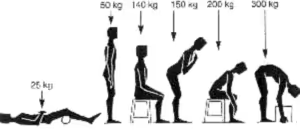
Back pain, also called the “pain of the century”, affects or will affect 80% of the population.
To act, we must first of all understand and be well informed: Dr. Zaïri, a neurosurgeon specializing in the spine, explains to us what the specific causes of low back pain are, how our work affects the health of our back and how to act to fight, prevent or relieve back pain.
Back pain or low back pain, what's the difference?

It is important not to confuse the Backache And the low back pain.
Back pain affects any part of the spine: the cervical, dorsal and lumbar areas. Low back pain, on the other hand, is the expression of a painful complaint located only on the last segment, which is the lumbar region. It is the most frequent complaint in the population since it concerns 3 French out of 4.
There are also different types of low back pain that can be classified according to:
- The intensity : mild, moderate or very intense;
- Characteristics : some are more painful at night, we then speak of inflammatory low back pain, there is also mechanical low back pain which is linked to the movements and the stress on the spine;
- The duration : less than 6 weeks, we talk about acute low back pain; between 6 weeks and 3 months, we talk about subacute low back pain; beyond 3 months it is a so-called chronic low back pain.
It is also possible to differentiate low back pain by the presence or absence of pain radiated to the leg (so-called pure or exclusive low back pain) or associated with sciatica or cruralgia (suffering from a nerve in the passage of the vertebrae).
Are there aggravating factors for low back pain?
Indeed, several factors are involved in the worsening of low back pain.
First of all, there are factors of family predisposition, we cannot really talk about inheritance because there is no clearly identified gene.
There are factors related to Morphotypes, or theobesity which will exaggerate the mechanical stresses on the column; as well as the smoking which will induce a lack of proper oxygenation of tissues and small arteries.
La sedentary lifestyle will also create a lack of strength training to support the spine during mechanical stresses or some sports that over-solicit the column.
Today, some professional activities are also recognized as source of disease. Mainly professions subject to handling with charging ports And unsuitable postures.
These are professions that use up the lumbar segments extremely quickly, but if we recognize these constraints, take them into account and prevents bad postures : we can avoid this kind of situation.
What are the consequences of carrying loads on the spine?
The charging port is a Increase in the force that is exerted on the lumbar spine, called axial force. As this zone is located at the base, it is the one that carries the most. And the more constraints we exert, the more the mobile segment (the disks and the joints between each vertebra) will be subjected to stresses and therefore increase the risk of acute injuries or chronic wear and tear.
[caption id="attachment_1467" align="aligncenter” width="300"]

Finally, it is a problem of adequacy between exaggerated mechanical constraints and the support capacities of the spine, which will be linked to age, but also muscular capacities, where the importance of back muscles. The differential will be absorbed by the mobile segment, which will therefore wear out more quickly.
When mechanical stresses are increased, Pressure is the cause or an aggravating factor in the chronicization of low back pain. So lowering this pressure makes it possible to reduce the pain or even to make it disappear.
In the workplace, in a well-targeted risky profession where we know that carrying heavy loads is important and repeated, and that it will be a source of back pain, reducing pressure will make it possible to neutralize the effect of this load carrying on the spine.
Based on this observation and thanks to its ambulatory traction system, the Japet.W exoskeleton makes it possible to reduce the pressure on the spine by 40%. It therefore limits exaggerated mechanical stresses when handling loads, thus protecting users from acute injuries or chronic wear and tear.
Are there postures that are more restrictive than others?
We realize that simple, physiological postures that we do every day will induce compression and mechanical stress on the intervertebral discs, which are not good for the back.

There is no hard and fast rule but a Leaning forward posture, with the center of gravity projected too far forward in relation to the lumbar spine, will induce a lever arm that increases mechanical stress. The same is true for movements in twists, which are weakening for the spine. If you combine these two movements, it becomes extremely penalizing and dangerous for the record.
Si these postures and these load carriers are carried out repeatedly, logically, the constraints are more regular so we further increase the risk of having acute injuries or chronic wear and tear. The human body is not made to do repetitive actions, even if we are often forced to do so. It is clearly today recognized in occupational medicine and you have to pay attention to it.
By maintaining the back in comfort zones, the Japet.W device limits the adoption of risky postures. He limits dangerous movements and refocuses on a physiological position, which makes it possible to limit excessive mechanical constraints and therefore better comfort.
We often talk about maintaining physical activity, how does this impact our spine?
We can't say it enough, The right treatment is movement : maintaining mobility is essential to fight against low back pain
In fact, when you remain immobile, there is a risk of muscular atrophy or musculotendinous retraction that will limit your ability to move and end up making each movement painful. Also, The less muscles we have, the less we have the support capacities of the spine, and at that moment, the least mechanical overload exerted on the column will no longer be absorbed by the muscles but will be absorbed by the mobile segment.
As you will have understood, the latter will therefore wear out, the pain will be increased and the risk of the pathology becoming more acute, affecting daily activities and the quality of life.
The Japet exoskeleton, motorized, follows and adapts in real time to the movements of the user. He thus preserves the muscular activity of the lumbar zone and therefore prevents muscle wasting in this area. This allows you to regain confidence in carrying out movements.
What can you do to prevent and relieve low back pain?
It is necessary identify risk factors and avoid them ! That is to say not smoking, having a regular sporting activity, avoiding overweight... By avoiding these risks, we are talking about maintaining good lumbar hygiene.
Besides, whether in personal or professional life, you must avoid deleterious postures, traumatic for the spine and especially their rehearsals.
When it is already too late, it is possible to masking the feeling of pain, by calming the inflammation by taking medications, painkillers, anti-inflammatories or even by doing infiltrations or manipulations of the spine.
To alleviate the cause of low back pain and relieve exaggerated mechanical stress, it is necessary to improve the muscular capabilities of the spine. In rarer cases, surgery is also a solution.
As you can see, take care of your back!



